In the world of rocks and minerals, the intense blue colour of the sodalite gemstone is incredibly rare. While it is one of the more affordable blue gems, it is also uncommon in jewelry. You won't usually find blue sodalite in your average mall jewelry store, so many shoppers consider their sodalite pieces incredibly unique parts of their jewelry collection.
If you are curious about sodalite, including its properties, history, and origins, here's a look at what this amazing stone is all about.
SODALITE PROPERTIES
The sodalite stone isn't actually a gemstone. Instead, sodalite is a mineral. Large, well-formed crystal sodalite is relatively rare because it can be prone to fracture. However, the structure makes sodalite a bit translucent, giving it a beautiful lustre. The white veining also adds interest and makes every piece look highly unique.

What does sodalite look like? While sodalite is best known for its deep royal blue colour, that isn't the only sodalite colour available. Along with violet-blue and light blue variants, sodalite may be grey creamy white, green, yellow, red, or colourless. It also has a weak orange fluorescence when exposed to UV light, which is considered a defining characteristic of sodalite.
Sodalite's Geological Properties:
-
Chemical Composition: Sodalite is a sodium aluminum silicate chloride mineral with the formula Na₈(Al₆Si₆O₂₄)Cl₂.
-
Colour: It's primarily blue but can also be found in shades of grey, yellow, green, or pink. The blue is often interspersed with white calcite or black nepheline.
-
Hardness: On the Mohs scale, sodalite ranks at about 5.5-6, making it relatively soft compared to other gemstones like diamonds or sapphires.
-
Crystal Structure: Sodalite has a cubic crystal system, but it's often found in massive form rather than well-defined crystals.
-
Transparency: It's generally opaque but can be translucent in thin pieces.
-
Lustre: It has a vitreous to greasy lustre.
-
Specific Gravity: The specific gravity usually ranges between 2.1 to 2.3.
THE HISTORY OF SODALITE
In the grand scheme of things, sodalite is a relatively new discovery. It wasn't officially found until the early 1800s when it was spotted in Greenland and formally recorded for the first time.
However, even though sodalite is a unique colour, it didn't gain traction, in the ornamental sense, until 1891. That's when significant sodalite deposits were discovered in Ontario, Canada.
Then, in 1901, when the Princess of Wales was at the World's Fair in Buffalo, New York, she received a gift of Sodalite that originated in Bancroft, Ontario. She became so enthralled with the stunning colouring that she made arrangements to get enough sodalite to decorate Marlborough House, her home in London. Over 130 tons of sodalite were sent to England for the royal residence. At that point, the Bancroft mine was dubbed the “Princess Sodalite Mine,” marking the occasion.

The Princess Sodalite Mine is still open today and is home to a vast rock and specimen shop and a 'rock farm' that is open to the public.
Plus, in 1991, hackmanite – also known as pink sodalite – was discovered in Quebec, Canada. That also made Canadian sodalite very prominent.

Sodalite in Ancient Civilizations:
-
Egyptian Culture: While sodalite itself may not have been prominent in ancient Egypt, similar blue stones like lapis lazuli were highly valued. They were believed to have spiritual significance and were used in amulets and other religious artifacts. Given sodalite's resemblance to lapis lazuli, it's possible that it could have been used or valued similarly if it had been more readily available.
-
Greek and Roman Influence: The name "sodalite" comes from the Latin 'sodalitas' and the Greek 'sodalios,' both meaning comrade or fellow member, owing to the community of elements found in the mineral. While there's no direct evidence of sodalite being used in ancient Greece or Rome, the name itself suggests a sense of community or fellowship, which could have cultural implications.
Sodalite in Indigenous Cultures:
-
Native American: While sodalite is not native to many regions traditionally inhabited by Native American tribes, the stone's blue colour is often associated with wisdom, clarity, and intuition in various Native American cultures. Similar blue stones were used in spiritual ceremonies.
-
South American Tribes: In some South American cultures, blue stones were believed to offer protection and were used in rituals and as talismans. While sodalite itself may not have been the primary stone used, its properties align well with these cultural beliefs.
-
Australian Aboriginals: Blue stones are often associated with the Dreamtime stories in Aboriginal culture, representing various aspects of their spirituality. While sodalite is not native to Australia, its characteristics could be seen as aligning with these spiritual beliefs
WHERE SODALITE IS FROM
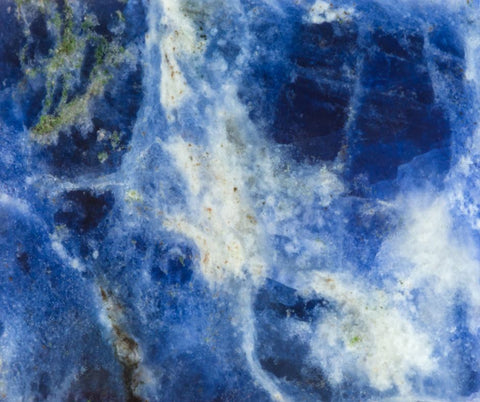
Sodalite can be found in several countries around the globe. Along with large deposits in several locations across Canada, sodalite is still found in Greenland, where it was first formally discovered. Plus, there are well-known sodalite sources in the United States (both in Arkansas and in Maine).
-
Canada: Bancroft, Ontario, continues to be a significant source of sodalite, particularly from the Princess Sodalite Mine. This location is well-known both locally and worldwide.
-
United States: While not explicitly stated as a major source, sodalite is found in some parts of the USA, including Michigan and Montana.
-
Brazil: Brazil is another country where sodalite is found, particularly in igneous rocks that crystallize from sodium-based magmas.
-
Afghanistan: Hackmanite, a variety of sodalite, has been found in the Koksha Valley in Afghanistan.
-
Other Locations: Smaller deposits of sodalite are found in South America (Brazil and Bolivia), Portugal, Romania, Burma, and Russia.
SODALITE JEWELRY
Tumbled, cut, and polished sodalite crystal can all be stunning. The deep blue colouring and striking white veining make each sodalite stone unique, giving it a natural level of quirkiness and visual interest.
In many cases, a sodalite bracelet features strung sodalite beads. This allows the wearer to have a variety of blue hues punctuated by white to gray veining. The colouring goes incredibly well with gold or silver accents, letting shoppers go with their metal of choice.
A sodalite necklace might also be made of strung sodalite beads. However, shoppers may spot the occasional sodalite pendant as well. These may include cut or polished sodalite stones, and the gemstone point look is often an incredibly popular sodalite pendant, as are sodalite cabochons.
When you look for sodalite jewelry, you might find necklaces and bracelets that only feature sodalite or options that combine sodalite with other stones. For example, when sodalite is strung next to topaz jade, you get colours that resemble surf and sand, a combination that is reminiscent of a day at the beach.
Introduction to the Spiritual Meaning and Uses of Sodalite
The sodalite stone meaning isn't fully agreed upon. When it comes to sodalite metaphysical properties, some believe that calming energy of the stone is calming and can help with inner truth or peace, while others think it connects strongly to communication and assists with focus. At times, sodalite is connected to writers and has even been called the Poet's Stone, though other gemstones have also been given that title, including the emerald.

Sodalite Spiritual Energy
The sodalite chakra is usually said to be the throat chakra based on its colouring. The throat chakra is associated with the colour blue, and its location may also explain why some believe sodalite is associated with communication or the ability to speak one's truth.
Spiritual Meaning:
-
Throat Chakra: Sodalite is often associated with the throat chakra, which governs communication. It's believed to help facilitate better communication and self-expression.
-
Third-Eye Chakra: It's also linked to the third-eye chakra, which is the center of intuition and foresight. Sodalite is said to enhance intuition and help you connect with your inner wisdom.
-
Truth and Honesty: Sodalite is often called the "stone of truth" and is believed to encourage honesty in both communication with others and inner self-talk.
-
Emotional Balance: The stone is thought to bring emotional balance and calmness, helping to reduce panic attacks and anxiety.
-
Intellectual Stimulation: Sodalite is said to stimulate the mind and help one to understand deeper philosophical principles. It's often used by those looking to understand the "bigger picture" of life.
What does sodalite help with?
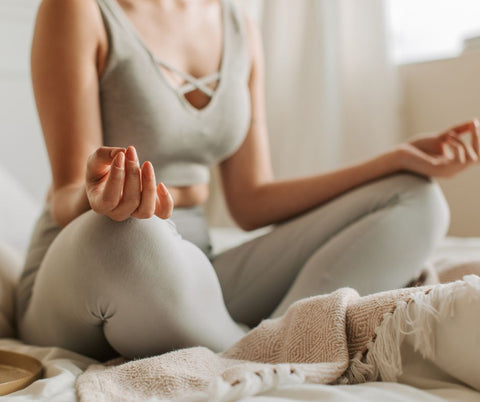
Sodalite healing properties are also a bit inconsistent. Depending on the belief system claims about the sodalite stone range from having the ability to bring emotional balance, boost the immune system, or improve self-esteem.

🌟 Need a little push forward? The Fierce Momentum Bracelet blends the uplifting energy of Citrine and Kyanite with the steady grounding of Obsidian and Sodalite. This bracelet is designed to inspire positive flow and keep your energy moving forward throughout the day. Colours vary naturally, making each piece unique.
Physical healing properties of Sodalite:
-
Throat and Vocal Cords: Given its association with the throat chakra, sodalite is sometimes used in holistic healing to alleviate throat-related issues like sore throats or vocal strain.
-
Endocrine System: Some believe that sodalite can balance the endocrine system and improve metabolism.
-
Blood Pressure: Sodalite is often used with the intention of balancing blood pressure levels, although there's limited scientific evidence to support this.
-
Immune System: It's thought to boost the immune system, helping the body to fight off illness more effectively.
-
Insomnia: Due to its calming properties, sodalite is sometimes used to treat insomnia or other sleep-related issues.
It's important to note that while many people believe in the healing properties of sodalite, scientific evidence is limited. Holistic healing practices like using sodalite should not replace conventional medical treatment but can be used as a complementary therapy. While wearing or holding sodalite shouldn't typically cause harm, sodalite shouldn't be viewed as a treatment or cure for any condition
How To Cleanse And Charge Sodalite Stones

Cleansing and charging your sodalite can be an important part of maintaining its energy and effectiveness, especially if you're using it for holistic or spiritual purposes. Here are some methods you can use:
Cleansing Methods:
-
Smudging: Use sage, palo santo, or other smudging herbs to cleanse the stone. Hold the sodalite in the smoke for a few minutes to remove negative energies.
-
Running Water: Hold the sodalite under running water for a few minutes. This is believed to wash away negative energy. However, be cautious with this method if your sodalite has any cracks or is combined with other, less water-resistant materials.
-
Salt Water: Some people use salt water for cleansing, but this method can be harsh on certain stones. If you choose this method, don't leave the sodalite in salt water for an extended period.
-
Sound Cleansing: Use a singing bowl, tuning fork, or even clapping to surround the sodalite with sound vibrations, which are believed to cleanse it.
-
Rice Method: Bury the sodalite in a bowl of brown rice overnight. The rice is believed to absorb the negative energies from the stone.
Charging Methods:
-
Moonlight: Place the sodalite under the moonlight, preferably during a full moon, to recharge its energies.
-
Sunlight: Some people also use sunlight to charge sodalite, but be cautious as prolonged exposure to direct sunlight can fade the colour of some stones.
-
Earth: Bury the sodalite in the earth for a few hours or overnight. The earth is believed to recharge the stone's energies.
-
Crystal Grids: Place the sodalite on a crystal grid with other stones that complement its energy. Quartz is often used as a central stone in these grids.
-
Intention Setting: Hold the sodalite in your hands and focus on your intentions for the stone. Visualize it being filled with the energy you need.
-
Reiki or Energy Work: If you're trained in Reiki or other energy work, you can use these techniques to charge your sodalite.
Precautions:
-
Always be gentle when cleansing and charging your sodalite to avoid scratching or damaging the stone.
-
If your sodalite is set in jewelry, be sure to consider the cleansing and charging methods that are also safe for the metal setting.
STONES SIMILAR TO SODALITE
Lapis Lazuli

When it comes to appearances, sodalite is frequently confused with lapis lazuli. The similar colouring can make it hard to spot the difference, particularly since lapis lazuli can actually contain sodalite and is also a beautiful blue ornamental stone.
Lapis Lazuli is a rock primarily composed of lazurite, calcite, and pyrite, known for its deep, intense blue colour, often accompanied by golden flecks of pyrite. It's slightly softer than sodalite, with a Mohs hardness of 5 to 5.5. The presence of pyrite gives lapis a unique, sparkling quality that sodalite lacks. Lapis has been highly valued for centuries and is often used in jewelry, carvings, and even as a pigment in ultramarine paint. Spiritually, lapis is associated with wisdom, truth, and enlightenment, which aligns well with Sodalite's focus on truth and communication.
Lapis Lazuli and sodalite are often compared due to their similar blue hues, but the golden pyrite inclusions in lapis and its rich historical significance set it apart. Both stones are popular choices for jewelry and have overlapping spiritual meanings, making them both valuable in different contexts. Sodalite is generally less expensive than lapis lazuli, hence its nickname "poor man's lapis".
Azurite
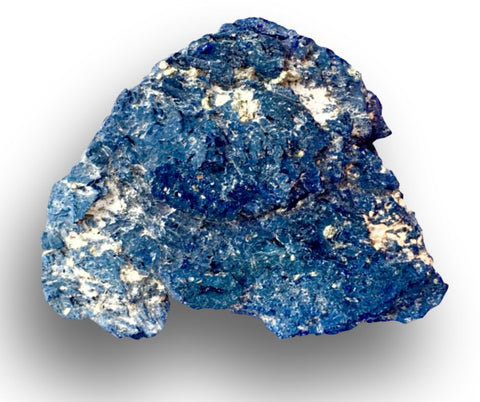
Azurite is a copper carbonate mineral known for its deep blue to greenish-blue hues. It's softer than sodalite, with a Mohs hardness of 3.5 to 4. While both stones are blue, azurite is often found alongside green malachite, giving it a unique colour combination. It's primarily used for ornamental purposes and sometimes in jewelry. Spiritually, azurite is believed to enhance intuition and creativity, similar to sodalite's association with intuition.
Dumortierite

Dumortierite is an aluminum borate silicate that ranges from blue to violet-blue. It's harder than sodalite, with a Mohs hardness of 7 to 8.5. While sodalite is often found with white calcite or black nepheline inclusions, dumortierite usually has a more uniform colour. It's used in high-grade porcelain and also in jewelry. Spiritually, dumortierite is associated with focus and intellectual abilities, somewhat akin to sodalite's reputation for promoting rational thought.
Kyanite
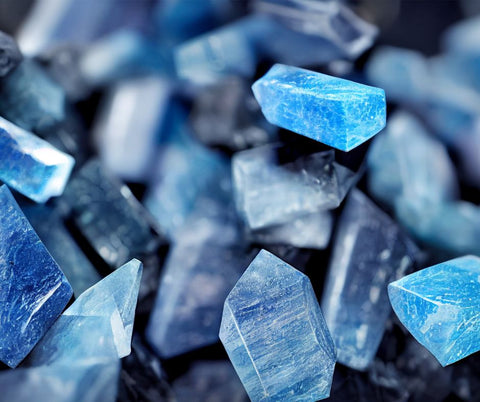
Kyanite is an aluminum silicate that comes in shades of blue to blue-green, although it can also occur in other colours. Its hardness varies depending on the crystal axis, ranging from 4.5 to 7 on the Mohs scale. Unlike sodalite and other crystals, kyanite often has a vitreous to almost pearly lustre and can be transparent. It's used in some porcelain products and in jewelry. Spiritually, Kyanite is known for balancing energy and enhancing psychic abilities, which aligns with Sodalite's focus on emotional balance.
Lazulite
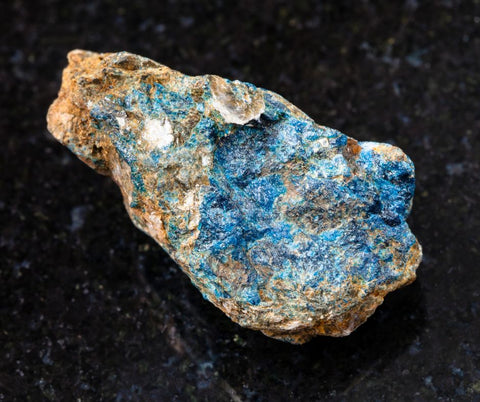
Lazulite is a magnesium iron aluminum phosphate with azure to dark blue colours. It has a similar hardness to sodalite, ranging around 5.5 to 6 on the Mohs scale. Lazulite is generally a lighter blue and has a higher specific gravity compared to sodalite. It's less commonly used in jewelry but is a favourite among mineral collectors. Spiritually, it's not as commonly cited as sodalite but shares the general association with enhancing intuition.
Each of these stones has its own unique properties, making them distinct from sodalite, but their beautiful blue hues often lead to comparisons. Whether you're considering them for their aesthetic appeal or their spiritual attributes, each offers something a little different.
Sodalite FAQs

What is sodalite stone good for?
Sodalite is a versatile stone often used for its aesthetic and spiritual properties. It's popular in jewelry and ornamental pieces. On a metaphysical level, it's believed to promote emotional balance, enhance communication, and stimulate rational thought. It's also used in holistic healing practices to address issues like anxiety and throat-related problems.
What does blue sodalite mean spiritually?
Spiritually, blue sodalite is associated with the throat and third-eye chakras. It's believed to foster better communication, enhance intuition, and promote emotional balance in everyday life. The stone is often called the "stone of truth," encouraging honesty in communication with others and within oneself.
Is sodalite crystal rare?
Sodalite is not considered a rare mineral. It's found in various parts of the world, including Canada, the United States, Brazil, and Russia. However, high-quality sodalite with intense blue coloration and fewer inclusions can be more uncommon and thus more valuable.
What are 3 facts about sodalite?
-
Sodalite was first discovered in Greenland in the early 1800s and gained prominence when large deposits were found in Ontario, Canada.
-
The stone often fluoresces orange under ultraviolet light.
-
Sodalite is named after its sodium content, with its name derived from the Latin word 'sodalitas,' meaning comrade or fellow member.
Can Sodalite be worn every day?
Sodalite can be worn every day, but it's essential to consider its relative softness, with a Mohs hardness of 5.5 to 6. This makes it susceptible to scratches and damage if exposed to harsh conditions. If set in jewelry, it's best to take it off while doing activities that could cause wear and tear.
How can you tell if sodalite is real?
Genuine sodalite typically has a royal blue colour with white calcite or black nepheline inclusions. It's often confused with lapis lazuli but lacks the golden pyrite flecks commonly found in lapis. To confirm its authenticity, you can also check its fluorescence; sodalite often glows orange under ultraviolet light.
How is sodalite formed?
Sodalite is primarily formed in igneous rocks that crystallize from sodium-rich magmas. It's commonly found in alkaline lavas and pegmatites. The mineral can also occur in metamorphic rocks that have come into contact with sodium-rich fluids.









